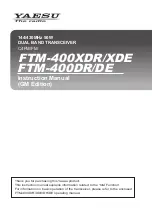
TXP-WTA_Instruction_Manual_(Rev1.3)
REV – 1.3
[34-2900-0207-4 ]
15
|
P a g e
4.2
RF Broadcast Cycle and Conserving Battery Life
Most TXP-WTA Sensor Transmitter battery power is consumed as the radio communicates to the wireless network.
Each broadcast cycle consists of the following operations.
1.
Power up the radio.
2.
Listen for the Server’s beacon.
3.
Synchronize to the Server’s hopping pattern to become “In Range”, transmit data packet out of the antenna
and return to sleep mode.
a.
This sequence takes from .25 to 1 second to complete.
b.
If the TXP-WTA Sensor Transmitter radio fails to synchronize hopping with the Server upon the initial
attempt it waits 6 seconds and tries again, then waits 6 seconds and tries once more.
c.
If the third attempt fails, an “Out of Range” icon is displayed, and the TXP-WTA Sensor Transmitter
goes to sleep and the scheduled broadcast cycle repeats.
NOTE: Transmit power levels are adjustable (900 MHz models only) and the lower the power setting the longer the
battery will last (see Section 4.4).
4.
Every 6 seconds, the sensor performs a “sniff test” to detect level of target gas present at the sensor. At
each “sniff test”, the Zzz’s “Sleep Mode” icon is briefly replaced by a status icon as described above in
Section 3.1.1. At this time, the LCD readout updates to indicate gas value measured during the sniff test.
The radio stays OFF and no broadcast occurs unless the gas value trips A1, A2 or A3 alarms, the Wakeup
Timer expires (maximum of 5-minutes) or the conditions shown below are met.
The TXP-WTA Sensor Transmitter’s radio may broadcast over the airwaves if:
•
Every time the Wakeup Timer Menu expires (see Section 8.1.3).
NOTE: This is important since the controller reports “Comm Error” for channels when no data is received after
[Wakeup Timer X 5]. For example, if the TXP-WTA Sensor Transmitter Wakeup Timer is set to broadcast every 5
minutes, the controller will indicate a Comm Error alarm for this channel if data is not received after
approximately 25 minutes.
•
After each 6 second sniff test if there is an A1, A2 or A3 alarm
NOTE: FAIL” alarms do not increase radio broadcast rates.
•
Upon entry into CAL MODE, upon entry into CAL PURGE and again upon completion of the CAL PURGE. A
status bit in the broadcast packet advises controllers and wireless relays that this TXP-WTA Sensor
Transmitter’s channel is being calibrated and alarms are inhibited.
NOTE: Oxygen sensors cause 20.9% controller readings during CAL MODE while all others cause zero readings
(see CAL MODE Section 5.3).
•
If the reading rises or falls by >2% of full scale since the most recent broadcast. This is to ensure a live
reading at the controller and/or wireless relay even though the Wakeup Timer might be set for a longer
interval (5 minutes max).
•
At the end of a Warmup interval (see Section 8.2.1).
•
As menu items are edited and again upon returning the LCD to the readings display.
















































